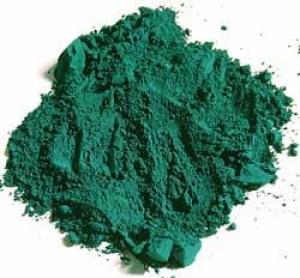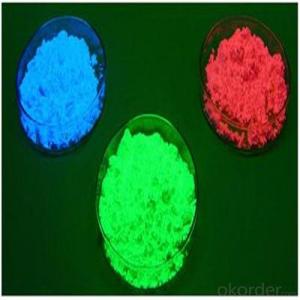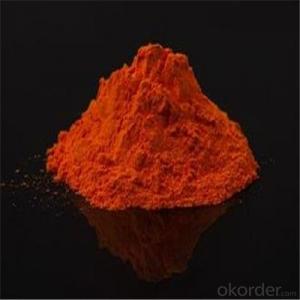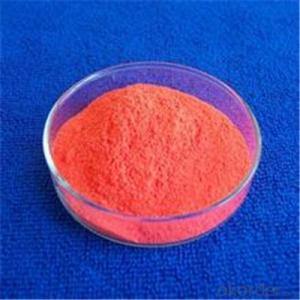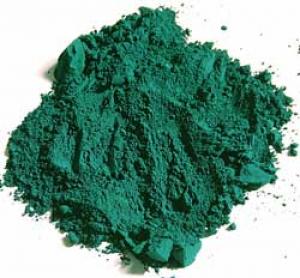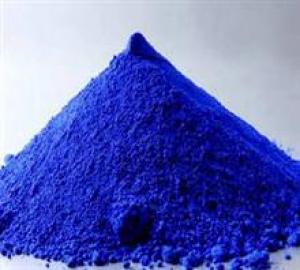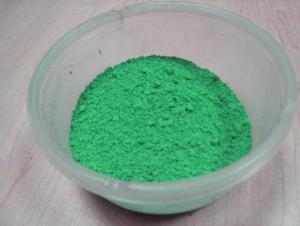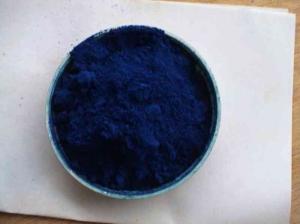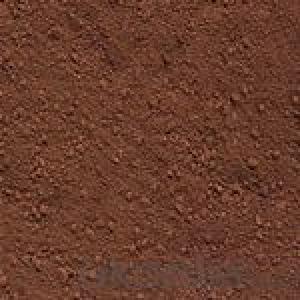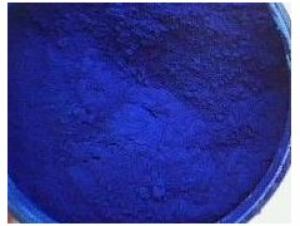Phthalocyanine Green G For masterbatch
- Loading Port:
- Qingdao Port
- Payment Terms:
- TT or LC
- Min Order Qty:
- 1 Metric Ton m.t.
- Supply Capability:
- 7,500MT/Year m.t./month
OKorder Service Pledge
OKorder Financial Service
You Might Also Like
Product Detail Of Phthalocyanine Green L8710 | |||||
Chemical Structure | CuPc Halide | ||||
Color Index No. | PG 7/74260 | ||||
Application | Paint | ||||
Physical Form | powder | ||||
| |||||
Test Items | Index | Test Method | |||
Relative Tinting Strength | 100 +_5% | DIN55986 | |||
ΔE,ΔL,Δa,Δb | ≤1,+1,+1,+1 |
| |||
| |||||
Items | Index | Test Method | |||
PH | 6.5~8 | DIN ISO 787-9 | |||
Density 20℃ g/cm3 | 2.1 | DIN ISO 787-10 | |||
BET m2/g | 61 | DIN 66131 | |||
Oil absorption g/100g | 32~42 | DIN ISO 787-5 | |||
105℃ Volatile Matter | ≤1.0% | DIN ISO 787-2 | |||
Water Solubles | ≤1.5% | DIN ISO 787-13 | |||
Residue on Sieve 100 mesh | ≤5% | DIN 53195 | |||
| |||||
Solvent Resistance | Index | Test Method | |||
Water | 5 | DIN ISO 105-A03 | |||
White Spirit | 4~5 | DIN ISO 105-A03 | |||
Ethanol | 4~5 | DIN ISO 105-A03 | |||
Acetone | 4~ 5 | DIN ISO 105-A03 | |||
Di methylbenzene | 4~5 | DIN ISO 105-A03 | |||
| |||||
Tolerance | Index | Test Method | |||
Light Fastness | 8 | DIN ISO 105-A03 | |||
Weather Resistance | 5 | DIN ISO 105-A03 | |||
Acid Resistance | 5 | DIN ISO 105-A03 | |||
Alkali Resistance | 5 | DIN ISO 105-A03 | |||
Hot Resistance | 230℃ |
| |||
Packing Details Of Phthalocyanine Green L8710 :
25kg/ PP bag , or as your requirements.
Applications Of Phthalocyanine Green :
1) Printing ink
2) Paint
3) Plastic
4) Rubber
5) Pharmaceuticals
6) Printing colors
7) Highly dispersible
8) High density pigment used for addition of coloration
9) Limited anti-dissolvent and anti-flocculability
10) High temperature resistance and sunshine resistance
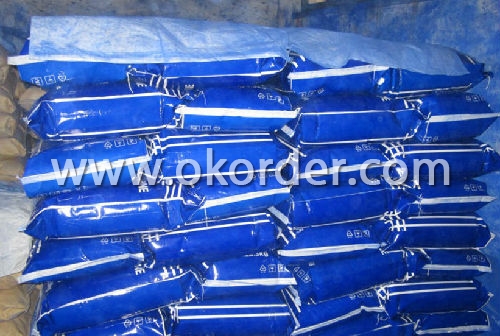
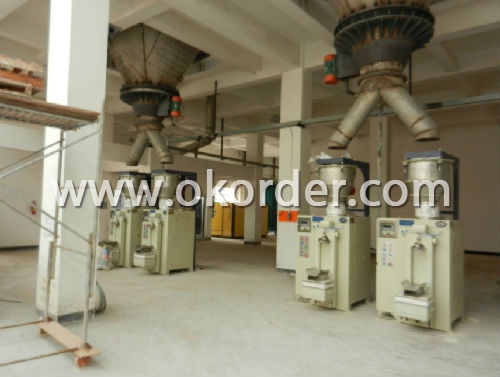
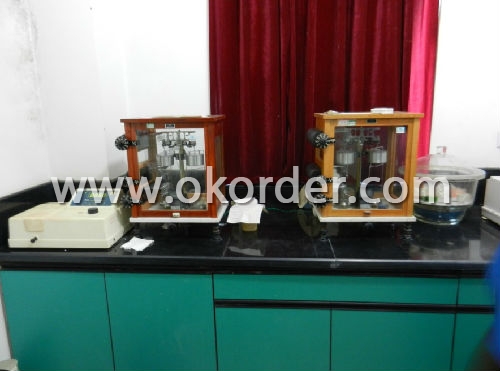
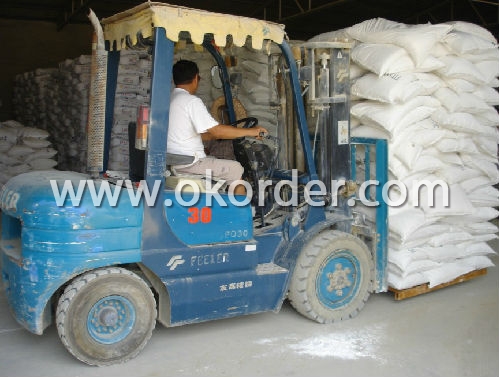
- Q: Please and thank you, it doesn't say so on the website.
- Mac Pigment Ingredients
- Q: can the pigment know as Chinese purple form a matter wave in certain circumstances?
- Scientists explore atomic mysteries of ancient pigment LOS ALAMOS, N.M., Nov. 18, 2004 -- University of California scientists from the National High Magnetic Field Laboratory, Pulsed Field Facility at Los Alamos National Laboratory, working with colleagues from Tokyo Metropolitan University, the University of Buenos Aires in Argentina, the National Institute of Chemical Physics and Biophysics in Estonia, the National High Magnetic Field Laboratory in Tallahassee, Florida and the University of Tokyo, have discovered an ideal candidate for Bose-Einstein condensation in the ancient Chinese pigment, Han Purple. In research featured recently on the cover of Physical Review Letters, the team describes how the application of a strong magnetic field to Han Purple (BaCuSi2O6) creates a gas of bosonic spin triplet excitations. The field acts as a chemical potential causing the weakly interacting bosonic gas to undergo Bose-Einstein condensation (BEC) when the temperature is reduced to minus 453 degrees Fahrenheit, six orders of magnitude higher than the temperature normally required for BEC in atomic gases.
- Q: I always hear about pigments from MAC and Loreal, etc. and I am confused about what exactly they are.So can someone please THOROUGHLY explain what they are and what they can be used for?
- Pigment okorder Pigments can be used for many different cosmetic purposes. eyeshadow blushes added to a clear gloss you make a brand new lip gloss added to clear nail polish base. a hilight color, added to body spray for shimmer added to gel for a tinted gel the list goes on and on. i hope this helps!
- Q: What do chlorophylls, cartenoids and phycobilins reflect? And what wavelengths of light do they absorb?
- Carotenoids generally reflect yellow, orange, or red and absorb blue to blue-green light spectra. Xanthophyll absorbs well at 400-530 nm Beta-carotene absorbs most strongly between 400-500 nm. Fucoxanthin absorbs light primarily in the blue-green to yellow-green that penetrates deeper in water, peaking at around 510-525 nm and again at 450-540 nm. This reflects a yellow brown giving brown algae their color. Phycobilins are not found in leaves except as a phytochrome. They occur in Cyanobacteria (bluegreen algae) and Rhodophyta's (red algae) photosynthetic pathways as accessory pigments a part of the light reaction pigment systems energy donors to the reaction center. Phytochromes respond to far red between 700-800 nm. Phycoerythrin is a phycobilin pigment in rad algae that reflects red light and is therefore responsible for the color of most red algae.
- Q: what is the relationship between chlorophyll a, accessory pigment?
- Sativa- uplifting, high, trippy, baked out of your gourd, ****** up, spacy Indica- passing out, baked, stoned, sleepy, couchlock, retarded, weird dreams
- Q: If you could explain it to me I would be very happy!
- Accessory pigments are light-absorbing compounds, found in photosynthetic organisms, that work in conjuction with chlorophyll a. They include other forms of this pigment, such as chlorophyll b in green algal and higher plant antennae, while other algae may contain chlorophyll c or d. In addition, there are many non-chlorophyll accessory pigments, such as carotenoids or phycobiliproteins which also absorb light and transfer that light energy to photosystem chlorophylls. Some of these accessory pigments, particularly the carotenoids, also serve to absorb and dissipate excess light energy, or work as antioxidants.
- Q: I love the colours that pigments come in but I don't know how to use them. Is there any easy way?
- You can go to a store that sells makeup and ask them how to use it. They will even show you.
- Q: What are iridescent magnetic effect pigments?
- Iridescent okorder /... (really long explanation)
- Q: wut is the diff between those 2?
- MAC pigment is a loose eyeshadow that comes in a jar. It is made with ingredients that help adhere to the skin it is also easy to blend and doesn't cake. It is also to use pigment if you want very intense colors. And MAC eyeshadow well it comes in a little case it is in powder form it's a lot easier to apply than the pigment because the pigment tends to get all over the place. Personally I like the eyeshadow better more shades and easier to apply.
- Q: how to prepare coloured pigments?
- Pigment does not might desire to do with pores and skin inevitably, a paint could be tinted with a pigment. curiously it is likewise a dry colorant, many times an insoluble powder. pores and skin colour is set by using the quantity of melanin in one's pores and skin, relative to ranges of exposure to the sunlight.
Send your message to us
Phthalocyanine Green G For masterbatch
- Loading Port:
- Qingdao Port
- Payment Terms:
- TT or LC
- Min Order Qty:
- 1 Metric Ton m.t.
- Supply Capability:
- 7,500MT/Year m.t./month
OKorder Service Pledge
OKorder Financial Service
Similar products
Hot products
Hot Searches
Related keywords


